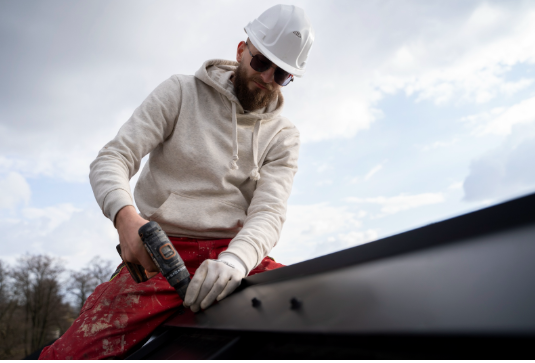Flat roofs are becoming common, not only at commercial buildings but even at some modern houses. People like them because it is convenient. They do not require much complex maintenance or assistance in energy conservation. A flat roof is superior to a sloped roof because it provides you with a place to install solar panels or HVAC systems and even a rooftop sitting space in certain instances.
You cannot just rush into having a flat roof installed. It requires planning, appropriate materials, and skilled hands to ensure that it is durable. There are a couple of things worth considering before you proceed with one.
Choosing the Right Roofing Material
The most important decision when it comes to flat roofs is picking the right material. There isn’t a one-size-fits-all answer here because different materials suit different climates, budgets, and building types.
- TPO (Thermoplastic Olefin): This is a popular option because it reflects sunlight really well, which makes it great for hot areas. It helps keep the building cooler and can even lower energy bills.
- EPDM (Ethylene Propylene Diene Monomer): This rubber-like material is very durable and especially resistant to things like hail damage. So, if you live in a place that gets a lot of storms, EPDM might make sense.
- PVC (Polyvinyl Chloride): Known for being tough and resistant to chemicals, PVC works well in industrial settings.
- Modified Bitumen: This is a layered roofing system that combines traditional asphalt with newer technology, making it strong and flexible.
Consider the weather conditions of your area, your budget, and the type of building you’re working with before making a final decision.
Look for a Reputable Roofing Company
Installing a flat roof isn’t the same as fixing up shingles on a sloped roof. It requires specialized skills and experience. A contractor who doesn’t know flat roofing well might leave you with leaks or drainage issues down the road. Look for a reputable roofing company that:
- Have specific experience with flat roofs.
- Are licensed and insured.
- Have certifications from the roofing material manufacturers
A reliable contractor will also give you honest advice, not just try to push the material that makes them the most money.
Proper Drainage
Water pooling is one of the most significant issues of flat roofs. Flat roofs require proper systems, unlike a sloped roof, where water simply slides off. When water accumulates, it may compromise the material, develop leaks, or even cause structural damage with time.
To prevent this, a properly designed drainage system is necessary. An experienced contractor will ensure that the roof is slightly sloped to ensure that the water will naturally be channeled to these drains.
Following Local Building Codes
Local building codes must be checked before you begin installing. Each city or region has its needs in terms of construction, and flat roofs are not an exception. It may have regulations regarding the type of materials to be used, the management of drainage, or the amount of insulation or cover.
Skipping this step may result in costly penalties or the necessity to repeat the work in the future.

